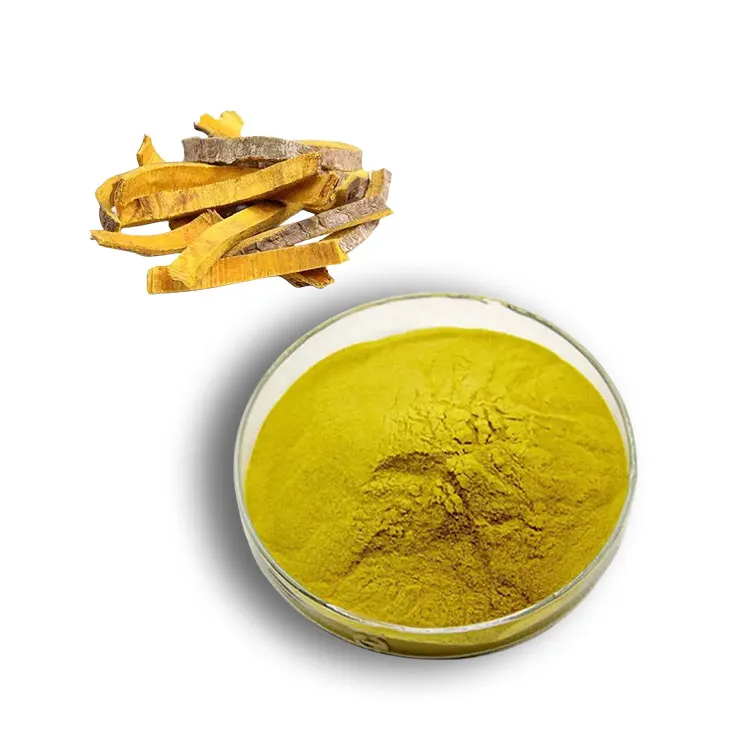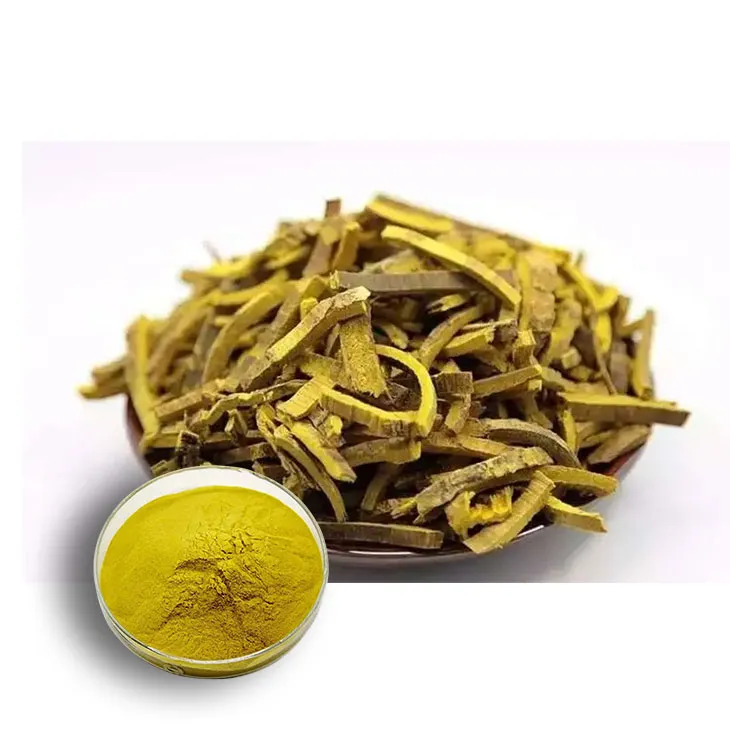- 0086-571-85302990
- sales@greenskybio.com
How to Extract Phellodendron Extract from Plants?
2024-12-02

Introduction
Phellodendron is a remarkable plant known for its rich medicinal properties. Extracts from Phellodendron have been used in traditional medicine for various purposes, such as anti - inflammatory, antibacterial, and anti - diabetic effects. The extraction process is crucial to obtain these valuable extracts. This article will delve into the detailed steps of extracting Phellodendron Extract from plants.

1. Plant Collection
1.1. Timing of Collection
The time of collecting Phellodendron plants is of great significance. Different parts of the plant may have different optimal collection times. For example, the bark of Phellodendron is often collected during a specific season when the active ingredients are at their peak concentration. In general, it is advisable to collect the plant parts when they are fully mature but not overly aged. This helps to ensure that the maximum amount of desired compounds is present in the plant material.
1.2. Collection MethodsWhen collecting Phellodendron plants, it is essential to follow proper methods to avoid damage to the plant and ensure sustainable collection. For the bark, it should be carefully stripped without harming the inner layers of the tree trunk. If collecting leaves or other parts, use clean and sharp tools to cut them off neatly. Also, make sure to collect from a healthy and unpolluted plant source. This may involve avoiding plants growing near industrial areas or areas with high pesticide use.

2. Preparation of Plant Material
2.1. Removal of Impurities
Once the Phellodendron plants are collected, the first step in preparation is to remove any visible impurities. This includes things like dirt, dead leaves, or small twigs that may be attached to the plant parts. For the bark, it can be gently brushed to remove surface dirt. Leaves can be rinsed with clean water if necessary, but care should be taken not to soak them for too long as this may cause leaching of some active ingredients.
2.2. Moisture RemovalReducing the moisture content of the plant material is another important aspect of preparation. Excess moisture can lead to mold growth during the extraction process, which can contaminate the extract. The plant material can be dried in a well - ventilated area, away from direct sunlight. For the bark, it can be sliced into thin pieces to accelerate the drying process. Leaves can be spread out thinly on a drying tray. The drying temperature should be kept relatively low, typically around 30 - 40°C, to prevent degradation of the active ingredients.

3. Extraction Methods
3.1. Maceration
Maceration is one of the traditional and commonly used methods for extracting Phellodendron Extract. In this method, the prepared plant parts are soaked in a suitable solvent for an extended period. The solvent penetrates the plant cells and dissolves the active ingredients. The choice of solvent is crucial in maceration. Commonly used solvents include methanol, ethyl acetate, and ethanol. For example, when using methanol as a solvent:
- Place the dried and prepared Phellodendron plant parts (such as the bark or leaves) in a clean, glass container.
- Pour the methanol over the plant material until it is completely submerged.
- Seal the container tightly to prevent evaporation of the solvent.
- Allow the mixture to soak for a period of time, usually several days to weeks. During this time, the methanol gradually extracts the active compounds from the plant cells.
- After the soaking period, the mixture is filtered to separate the plant residue from the methanol extract. This can be done using filter paper or a filtration device.
Percolation is another effective extraction method. In percolation, the solvent slowly passes through the plant material, continuously extracting the active ingredients. Here is how percolation can be carried out:
- Prepare a percolation apparatus, which typically consists of a tall, narrow column with a porous base.
- Place the dried Phellodendron plant material in the percolation column, packing it evenly.
- Slowly pour the chosen solvent (such as ethyl acetate) onto the top of the plant material. The solvent will start to percolate through the plant material under the influence of gravity.
- The percolated solvent, which now contains the extracted compounds, is collected at the bottom of the column.
- To ensure complete extraction, the process can be repeated several times with fresh solvent.

4. Solvent Selection
4.1. Influence on Extract Quality
The choice of solvent has a significant impact on the quality of the Phellodendron Extract. Different solvents have different affinities for various active ingredients. For example, methanol is a polar solvent and is effective in extracting polar compounds such as alkaloids present in Phellodendron. Ethyl acetate, on the other hand, is a less polar solvent and may be more suitable for extracting non - polar or moderately polar compounds. The solubility of the active ingredients in the solvent determines the type and amount of compounds that are extracted, which in turn affects the medicinal properties of the final extract.
4.2. Influence on Extract QuantityThe solvent also affects the quantity of the extract obtained. A solvent that has a high solubility for the active ingredients will be able to extract a larger amount of the desired compounds. However, it is also important to consider the selectivity of the solvent. A solvent that extracts too many impurities along with the active ingredients may result in a lower - quality extract. Therefore, a balance needs to be struck between the quantity and quality of the extract when selecting a solvent.
5. Concentration and Drying
5.1. Concentration
After the extraction process, the resulting extract is usually in a dilute form. Concentration is required to increase the concentration of the active ingredients in the extract. This can be done using techniques such as evaporation. For example, if the extract is in a methanol solution, the methanol can be evaporated under reduced pressure at a controlled temperature. This helps to remove the solvent while minimizing the loss of active ingredients. A rotary evaporator is often used for this purpose, which allows for efficient and controlled evaporation of the solvent.
5.2. DryingOnce the extract has been concentrated, drying is the final step to obtain the solid Phellodendron extract. Drying can be carried out in a vacuum dryer or a freeze - dryer. A vacuum dryer removes the remaining moisture or solvent by applying a vacuum and gentle heat. A freeze - dryer, on the other hand, first freezes the extract and then sublimates the ice (if any) and solvent under vacuum. Freeze - drying is often preferred as it can better preserve the structure and activity of the active ingredients in the extract.
6. Conclusion
The extraction of Phellodendron extract from plants is a multi - step process that requires careful attention at each stage. From plant collection to the final drying of the extract, every step influences the quality and quantity of the resulting product. By following the proper procedures for collection, preparation, extraction, solvent selection, concentration, and drying, it is possible to obtain high - quality Phellodendron extracts with valuable medicinal properties.
FAQ:
What is the best time to collect Phellodendron plants for extraction?
The best time to collect Phellodendron plants for extraction usually depends on the specific part of the plant being used and its growth cycle. Generally, it is advisable to collect when the active ingredients in the plant are at their peak. For example, for some species, it might be during the late spring or early summer when the plant has fully developed but has not yet started to wither. However, it is crucial to follow relevant regulations and sustainable collection practices to ensure the long - term availability of the plant resources.
How can impurities be effectively removed during the preparation stage?
During the preparation stage, impurities can be effectively removed in several ways. One common method is by carefully washing the plant parts with clean water to remove dirt, soil, and other visible contaminants. Then, drying the plant material thoroughly can also help in getting rid of small particles and moisture - associated impurities. Additionally, sorting the plant parts by hand can be useful to separate any unwanted parts such as damaged or diseased sections of the plant.
What are the advantages and disadvantages of maceration compared to percolation?
Advantages of maceration: It is a relatively simple method. It allows for a more thorough extraction as the plant parts are soaked for a long time, which can ensure that a large amount of the active ingredients are dissolved in the solvent. Disadvantages: It may take a long time, usually several days to weeks depending on the plant material. Also, there is a risk of microbial growth during the long - soaking process. Advantages of percolation: It is a more dynamic process where the solvent continuously passes through the plant material, which can lead to a more efficient extraction in a shorter time compared to maceration. It also reduces the risk of microbial contamination as the solvent is constantly flowing. Disadvantages: It requires more complex equipment setup compared to maceration, and it may not extract all the active ingredients as thoroughly as maceration if not properly optimized.
How does the choice of solvent impact the properties of the Phellodendron extract?
The choice of solvent has a significant impact on the properties of the Phellodendron extract. Different solvents have different polarities and solubilities. For example, methanol, a polar solvent, can dissolve polar compounds in the Phellodendron plant effectively. If methanol is used as a solvent, the extract may contain a higher proportion of polar active ingredients. Ethyl acetate, which is less polar, may extract different components compared to methanol. The solvent also affects the yield of the extract. A solvent that has a better affinity for the active ingredients in the Phellodendron will generally result in a higher - quality and greater - quantity extract.
What are the key considerations in the concentration and drying processes?
In the concentration process, one key consideration is to control the temperature carefully. High temperatures may cause degradation of some of the active ingredients in the Phellodendron extract. Therefore, gentle heating methods are often preferred. Also, the rate of evaporation should be monitored to ensure that the desired concentration is achieved without losing too much of the valuable components. In the drying process, proper ventilation is important to ensure that moisture is removed completely. Drying at too high a temperature can lead to the formation of hard - to - dissolve crystals or cause changes in the chemical composition of the extract. It is also necessary to choose the appropriate drying method, such as air - drying, vacuum - drying, or freeze - drying, depending on the nature of the extract and the requirements for its final form.
Related literature
- Studies on the Extraction and Bioactivity of Phellodendron Compounds"
- "Optimization of Phellodendron Extract Extraction Methods"
- "The Chemical Composition and Medicinal Properties of Phellodendron Extracts"
- ▶ Hesperidin
- ▶ Citrus Bioflavonoids
- ▶ Plant Extract
- ▶ lycopene
- ▶ Diosmin
- ▶ Grape seed extract
- ▶ Sea buckthorn Juice Powder
- ▶ Fruit Juice Powder
- ▶ Hops Extract
- ▶ Artichoke Extract
- ▶ Mushroom extract
- ▶ Astaxanthin
- ▶ Green Tea Extract
- ▶ Curcumin
- ▶ Horse Chestnut Extract
- ▶ Other Product
- ▶ Boswellia Serrata Extract
- ▶ Resveratrol
- ▶ Marigold Extract
- ▶ Grape Leaf Extract
- ▶ New Product
- ▶ Aminolevulinic acid
- ▶ Cranberry Extract
- ▶ Red Yeast Rice
- ▶ Red Wine Extract
-
Grapefruit Seed Extract Powder
2024-12-02
-
Curcumin
2024-12-02
-
Uridine-5'-monophosphate Disodium salt
2024-12-02
-
Chia Seed Powder
2024-12-02
-
Reishi mushroom extract
2024-12-02
-
Hericium erinaceus extract powder
2024-12-02
-
Cat Claw Extract
2024-12-02
-
Coix Seed Extract
2024-12-02
-
Europen Bilberry Extract
2024-12-02
-
Rosemary extract
2024-12-02





















